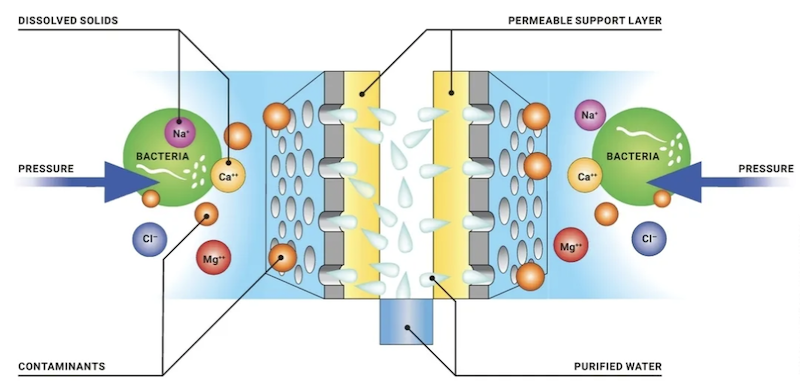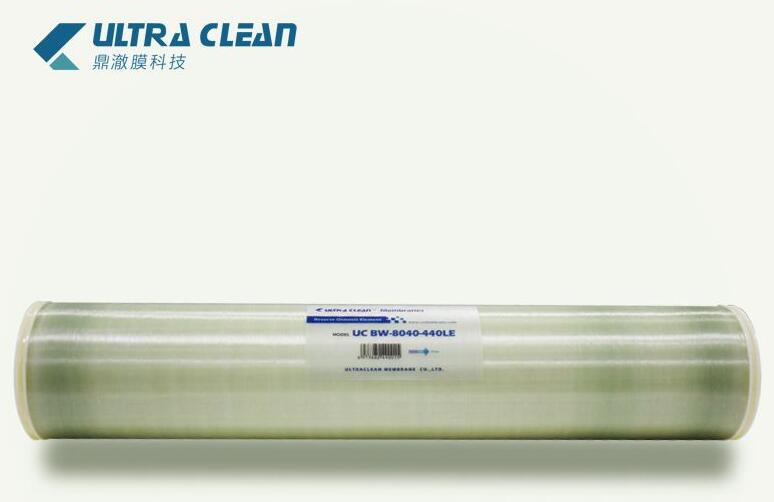As the global population continues to grow and industries develop, the sustainable supply of clean drinking water and a wide range of other processes pose a major challenge in every corner of the world. In the face of this growing demand, desalination and water reuse technologies are being deployed to ensure a continuous and uninterrupted supply to communities and businesses through reverse osmosis (RO), one of the most cost effective and efficient methods.
Unlike traditional filtration methods that use screens or filters to extract particles, reverse osmosis (RO) is a pressure-driven process that utilizes semi-permeable membranes and the principle of staggered flow filtration.RO membranes provide the finest filtration, designed to prevent the passage of salts and organic molecules with approximate molecular weights greater than 100. This means that RO membranes can effectively remove common water contaminants, including bacteria, agricultural chemicals, nitrates, sugars, soluble salts and metal ions.
In normal osmosis, when a semi-permeable membrane separates solutions of different solute concentrations, the lower concentration flows into the higher concentration to reach equilibrium: the solute concentrations on both sides of the membrane are equal. As the amount of solution on the higher concentration side increases, the pressure across that column of water rises until it is high enough to impede the flow of the lower concentration solution across the membrane. This is where osmotic pressure comes into play.
In RO, a pressure in excess of the system's osmotic pressure is applied to the system. The pressure forces the higher concentration solution back across the semi-permeable membrane, leaving behind the solute that is blocked by the semi-permeable membrane.

A high-pressure pump continuously pumps feed water into the elements of an RO water treatment system. This pressure forces some water through the semi-permeable RO membrane, resulting in a low salt or purified product called permeate on one side and a high salt or concentrated brine called concentrate or waste solution on the other side.
A concentrate valve controls the percentage of feed water entering the concentrate stream and the permeate. In this system, the low salinity or purified permeate (feed water passing through the membrane) is kept separate from the concentrate stream. The concentrate stream removes concentrates that cannot pass through the membrane and sweeps them out of the system.
Thin film composite reverse osmosis membranes consist of three layers, each with a different purpose. The thickest layer is a support paper made of polyester (PET) or polypropylene (PP), which is responsible for maintaining the structural integrity of the membrane. Although only about 100 microns thick, the support paper ensures that the membrane can withstand the high pressures and temperatures to which it may be subjected during pressurization and extended use.
The film layer made of polyamide (PA) that performs the separation is the thinnest, only a quarter of a micron. By making subtle changes to the polyamide chemistry, you can alter the properties of the solute rejects.
Between them is a polysulfone (PSf) support layer, about 50 microns thick. This bonds the thin film membrane layer to the support paper while ensuring consistent, defect-free application by smoothing out the rough and irregular outer surface of the support paper.

Much like membranes, the resulting RO elements can be constructed in a variety of configurations depending on the intended application and the desired performance profile. It is generally accepted that spiral wound elements offer the easiest maintenance solution with lower element replacement costs and simpler piping systems than tubular, plate and frame or hollow fiber designs.
Elements produced using automated manufacturing processes can provide higher performance than those assembled manually because of precise blade set placement and uniform glue line passage maximizing the effective area available to produce penetration.
The precise design of the element depends on the intended application environment. For example, when RO elements are used for desalination, consideration needs to be given to effectively managing biological contamination caused by salt and other molecular buildup and the resulting impact on filtration efficiency. Chemical cleaners can be used to backwash deposits, however, these can shorten the life of the membrane, so alternative solutions have been developed. You can now find RO elements with specialized anti-biofouling properties that reduce sediment buildup, improve their overall efficiency and provide longer system uptime as demand is reduced.

Reverse Osmosis Membrane Elements
As mentioned above, RO elements can be used for desalination to provide clean water to coastal communities that lack alternative water sources, however, this is just one of many different applications for this water technology, including food and beverage processing, biomedical separation and industrial process water treatment.
In addition to providing finer filtration than nanofiltration or ultrafiltration, RO can also be used as a pretreatment process for ion exchange (IX) processes, significantly reducing the operating costs and regeneration frequency of IX systems.
RO components are also increasingly used in wastewater treatment, promoting greater water reuse while reducing waste discharge and allowing recovery of valuable by-products such as metals, salts, organic biosolids and other minerals.
While zero liquid discharge (ZLD) remains the gold standard, the cost of achieving this theoretical ideal is very high and too costly for many industries, especially in developing countries, due to the thermal processes involved. In contrast, RO components can be used in Minimum Liquid Discharge (MLD) systems, which result in less than 5% concentrate remaining, with the remaining 95% having been converted to pure water and salt. Optionally, the remaining concentrate can be placed under thermal pressure, effectively coupling the MLD and ZLD solutions together, resulting in cost savings of up to 60% compared to using only thermal ZLD.
We are exploring how next-generation membranes can provide even greater efficiency. We have found that by controlling the density of the membranes, they can increase the efficiency of reverse osmosis elements by 30 to 40 percent, increasing water production while reducing energy consumption. The researchers mapped the path of water through the nanoscale membranes, and their findings suggest that inconsistencies in density and mass distribution have a greater impact on performance than the thickness of the membrane.
While the research is ongoing, it is clear that reverse osmosis elements have the potential to make water purification and desalination processes more sustainable, productive and economical, laying a solid foundation for this water technology.
Copyright:@2020-2021
Comments Please sign in or sign up to post.
0
0 of 500 characters used